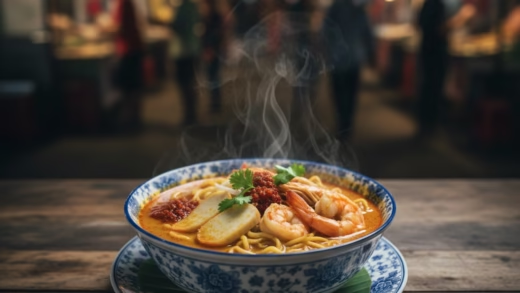Asam Pedas
Asam Pedas, which translates to “sour spicy,” is a traditional and highly popular stew in Southeast Asia, particularly in Malaysia, Indonesia, and Singapore
Origin
Asam Pedas (literally “sour and spicy”) originates from the Malay communities of Malacca and Johor in Peninsular Malaysia. The dish has deep roots in Peranakan and Malay culinary traditions and is also popular in Sumatra, Indonesia. It reflects centuries of cultural exchange and coastal influences, especially among fishermen communities.
Category
Main Course – Traditional Malaysian Stew/Curry
Appearance
Asam Pedas is a vibrant red curry with chunks of fish swimming in a tangy, spicy gravy. The sauce glistens with chili oil and is often served with white rice or nasi lemak. Garnishes of fresh herbs and okra add a splash of green.
Ingredients
- Fish (usually mackerel, stingray, or red snapper)
- Tamarind juice (asam jawa)
- Dried red chilies
- Shallots and garlic
- Lemongrass
- Ginger or galangal
- Turmeric
- Okra and tomatoes
- Cooking oil, salt, and sugar
Preparation
- Blend dried chilies, shallots, garlic, lemongrass, and turmeric into a smooth paste.
- Sauté the paste until fragrant and the oil separates.
- Add tamarind juice and water to create the tangy broth.
- Simmer the fish until cooked through.
- Add okra and tomatoes, then adjust salt and sugar to taste.
Equipment
- Blender or mortar and pestle
- Wok or clay pot
- Wooden spoon
- Strainer (for tamarind pulp)
Variations
- Asam Pedas Melaka: Classic sour-spicy version with tamarind and chili.
- Asam Pedas Johor: Richer flavor with added spices like cumin and coriander.
- Asam Pedas Ikan Pari: Uses stingray for a unique texture.
- Vegetarian Asam Pedas: Replaces fish with tofu, tempeh, or eggplant.
Taste
A perfect harmony of spicy heat and sour tang, balanced by subtle sweetness from tomatoes and sugar.
Texture
The gravy is smooth and slightly oily, while the fish remains tender and flaky. Okra adds a slight crunch.
Aroma
Fragrant and appetizing, with hints of lemongrass, chili, and tamarind wafting through the air.
Sound
The gentle sizzle of the chili paste frying in oil – known locally as tumis hingga pecah minyak – signals the dish’s signature aroma and depth of flavor.
Cultural Significance
Asam Pedas represents Malay home cooking at its finest. It’s a dish often served during family gatherings and community feasts, symbolizing warmth and hospitality.
Symbolism
The balance of sour and spicy flavors mirrors the balance of emotions in life – joy, struggle, and harmony – deeply rooted in Malay culinary philosophy.
Regional Cuisine
A staple in Malacca, Johor, Negeri Sembilan, and Perak, each region has its unique twist. In Malacca, Peranakan influences add depth with fermented shrimp paste (belacan).
Social Context
Asam Pedas is commonly enjoyed at local warungs (small eateries) and family kitchens. It’s also featured in festivals, wedding banquets, and Ramadan bazaars.
Nutritional Information (per serving, approximate)
| Nutrient | Amount |
|---|---|
| Calories | 220 kcal |
| Protein | 18 g |
| Fat | 10 g |
| Carbohydrates | 12 g |
| Fiber | 2 g |
| Sodium | 300 mg |
Health Benefits
- High in protein and omega-3 (from fish)
- Contains antioxidants from chilies and turmeric
- Tamarind aids digestion and detoxification
Dietary Restrictions
- Halal friendly
- Gluten-free if no soy sauce or processed additives are used
- Not suitable for strict vegans unless adapted
Allergens
- Fish
- Possible traces of shrimp paste (belacan)
- Tamarind (for those with sensitivity to sour foods)
Cost
Generally affordable – typically RM 8–15 per serving at local eateries, slightly higher in restaurants.
Production
Most Asam Pedas pastes are still homemade, though commercial spice pastes are available in supermarkets. Local small businesses often prepare them in small batches for sale.
Sustainability
Sustainable versions use locally caught fish and organic vegetables. Avoiding overfished species like stingray contributes to marine conservation.
Availability
Widely available in Malaysian restaurants, food courts, and hawker stalls. Also served in Singapore and Indonesian eateries.
History
The dish dates back to the 15th century Sultanate of Malacca, influenced by Malay fishermen and Peranakan traders. It evolved from simple sour stews cooked on fishing boats to a refined delicacy found across Malaysia today.
Anecdotes
Locals say the best Asam Pedas is cooked a day before eating – allowing the flavors to deepen overnight. In Malacca, families guard their spice paste recipes as closely as family heirlooms.
How to Prepare at Home
- Soak dried chilies and blend with shallots, garlic, and lemongrass.
- Sauté the paste until aromatic.
- Add tamarind juice and bring to a boil.
- Add fish, okra, and tomatoes.
- Simmer until fish is tender and sauce thickens.
- Serve hot with rice.
FAQ
Q1: What fish is best for Asam Pedas?
A: Mackerel, stingray, or red snapper are traditional choices for their firm texture.
Q2: Is Asam Pedas very spicy?
A: It’s moderately spicy, but you can adjust the heat by reducing the chili quantity.
Q3: Can I make it vegetarian?
A: Yes, replace fish with tofu or eggplant and skip shrimp paste.
Q4: How long does it keep?
A: It lasts up to 2–3 days refrigerated and tastes even better the next day.
Q5: What is served with Asam Pedas?
A: Typically with steamed rice, salted egg, and stir-fried greens.
In essence, Asam Pedas is more than just a dish — it’s a symbol of Malaysia’s vibrant heritage, showcasing the perfect balance of flavors that define Southeast Asian cuisine.








Comments are closed.